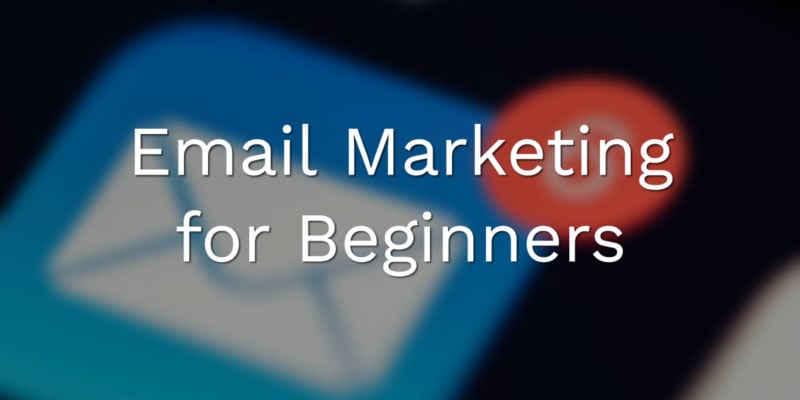Email marketing still outperforms many other channels, returning 3600% in ROI.
That’s more than enough motivation to explore how it can grow your business. It’s personal, it’s measurable, and it doesn’t require a massive budget. Whether your priority is boosting sales, building customer loyalty, or sharing news and updates, email campaigns remain a proven strategy for reaching individuals where they spend much of their online time: their inbox.
This guide shows you how to leverage email effectively, from building a quality subscriber list to running campaigns that get results.
Why Email Marketing?
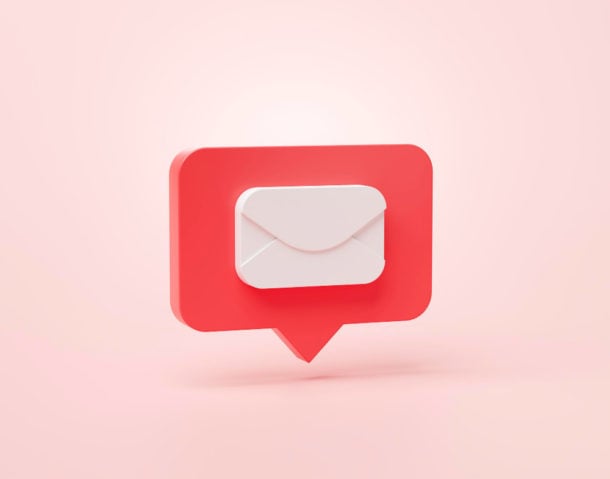
You might be thinking, “With all the social media and online channels out there, isn’t email marketing a bit outdated?” Well, let me tell you, email is still one of the most effective and reliable ways to reach your target audience and achieve your marketing goals. Here’s why:
Exceptional ROI
Email marketing consistently delivers impressive returns on investment. Studies show from Litmus that for every $1 spent, email marketing generates an average return of $36, thats 3600% in ROI. Imagine the potential for growth when you invest in a channel that yields such significant returns.
Targeted and Personalized Communication
Unlike other digital channels where you broadcast your message to a broad audience, email allows you to segment your audience and personalize your messages based on interests, demographics, and behavior. This ensures relevance and boosts opens, clicks, and conversions.
Measurable Results
With email marketing, you can track key metrics like open rates, click-through rates, and conversions in real-time. This data-driven approach allows you to measure campaign effectiveness, identify areas for improvement, and make decisions based on solid evidence.
Cost-Effectiveness
Compared to other marketing channels like paid ads or social media campaigns, email marketing is relatively inexpensive. Many platforms offer free or affordable plans, making it accessible to businesses of all sizes.
Scalability
Email marketing is highly scalable. Automation features allow you to handle tasks like welcome emails and lead nurturing with ease. This lets you grow your reach without needing a huge team, which is ideal for businesses serving larger audiences.
Simple Steps to Start Email Marketing
You now see the value of using email to connect with your customers. The next phase is getting set up with the basic elements that will make your campaigns a success. These steps will help you clarify your goals, grow a quality subscriber list, and choose the right platform.
1. Define Your Goals
Before you dive in, it’s crucial to decide what you want to achieve with your email campaigns. Ask yourself, “Am I trying to increase brand awareness, drive site traffic, generate leads, nurture existing leads, promote sales, improve customer retention, or foster loyalty?”
Specific goals shape your email strategy. If your priority is lead generation, focus on creating lead magnets and opt-in forms. If you want to drive sales, promotional emails might be your top choice.
2. Build Your Email List
Your email list is the backbone of your efforts. Always build an organic list of engaged subscribers who gave explicit permission. Below are a few ways to do that:
- Offer valuable content Provide free ebooks, guides, checklists, or webinars in exchange for an email address.
- Use opt-in forms Place forms on your website, landing pages, and social channels. Offer a clear incentive.
- Run contests and giveaways Discounts or exclusive content can motivate sign-ups.
- Host webinars and online events Capture addresses during registration⁶.
- Use social media Promote your list on social platforms⁶, or run ads to expand your reach.
- Include a compelling offer A discount, free shipping, or special content can be effective.
Important: Avoid buying email lists, which can harm your sender reputation and may violate regulations⁸. A solid email list takes time to grow but pays off in the end.
See our article on how you can grow your email faster.
Example: A Well-Designed Opt-In Form
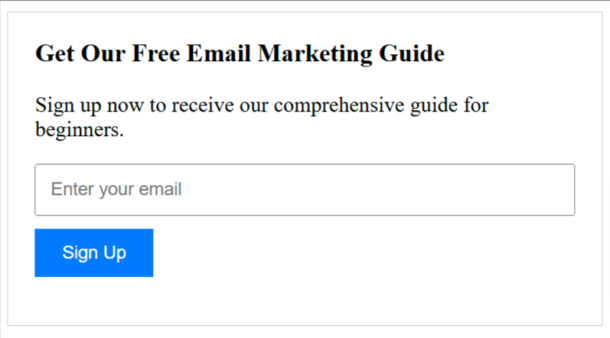
3. Choose an Email Marketing Platform
An email marketing platform helps you organize your list, create and send campaigns, and see how well they perform. Consider your budget, audience size, and desired features (like automation, segmentation, A/B testing) before selecting a platform. Below is a quick comparison:
| Platform | Best for | Standout Features | Free Plan |
|---|---|---|---|
| MailerLite | Advanced email marketers | Dynamic content blocks | Up to 1,000 subscribers, 12,000 emails/month |
| Brevo | All-in-one marketing & sales | Full-featured CRM | Up to 300 emails/day, 100,000 contacts |
| Kit | High volume senders | Digital products | Up to 10,000 subscribers, unlimited emails |
| Sender | Generous free plan with automation | Pre-built automation flows | Up to 2,500 subscribers, 15,000 emails/month |
| Mailchimp | Beginners & small businesses | User-friendly interface | Up to 500 contacts, limited features |
| HubSpot Marketing Hub | Integrated CRM focus | Advanced automation & personalization | Free plan with limited features |
| Constant Contact | Small businesses & beginners | Easy to use with support | No free plan, free trial available |
| Moosend | Affordable, advanced features | Landing pages & CRM tools | Free plan with limited features |
4. Stay Compliant with Regulations
Familiarize yourself with laws designed to protect consumers:
- CAN-SPAM Act (US) Accurate sender info, a clear opt-out option, and a valid postal address are mandatory.
- GDPR (EU) Requires explicit consent for email marketing and offers strong data protection rights.
- CASL (Canada) Prohibits sending commercial emails without consent and demands correct sender information.
Check out this article to know why your emails are getting flagged as spam.
How to Create Effective Email Campaigns
Once you have a plan, a growing list, and a suitable email platform, it’s time to design messages that capture attention. Below are methods to make sure your emails stand out and drive action.
1. Segment Your Audience
Break your list into smaller groups based on shared traits—demographics, interests, or engagement level. Segmented emails often see higher open rates and conversions.
2. Write Impactful Subject Lines
Subject lines shape a recipient’s choice to open or ignore your email. Follow these tips:
- Stay brief (under 50 characters)
- Use power words (“free,” “exclusive,” “limited”)
- Personalize by including the recipient’s name
- Add urgency (“Don’t miss out,” “Last chance”)
- Avoid spam triggers (ALL CAPS, excessive punctuation)
Example Subject Lines
- Subject: New arrivals: Shop our latest collection
- Subject: John, your exclusive discount is waiting
- Subject: Final hours: 50% off sale ends tonight
Check out our article on why scarcity tactic work, and how do it ethically.
3. Write Engaging Email Copy
After someone opens your email, keep their attention with relevant, concise text:
Example: Simple Promotional Email in a Preview-Style Format
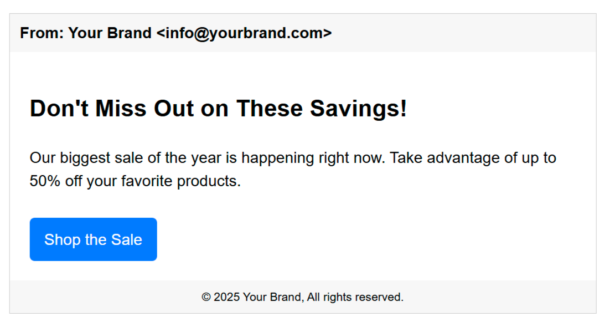
4. Mobile-Friendly Design
With many people checking email on phones, it’s vital to ensure your messages adapt to different screen sizes.
Example: Mobile-Responsive Layout
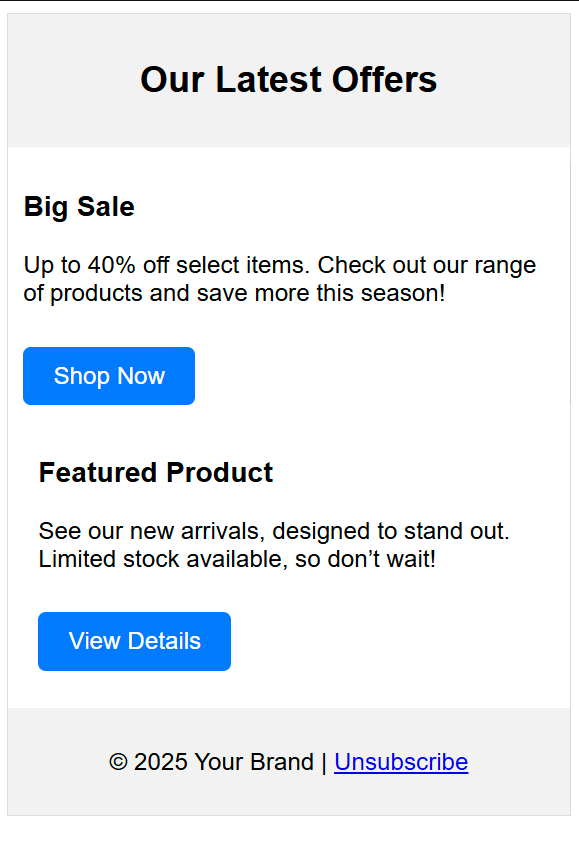
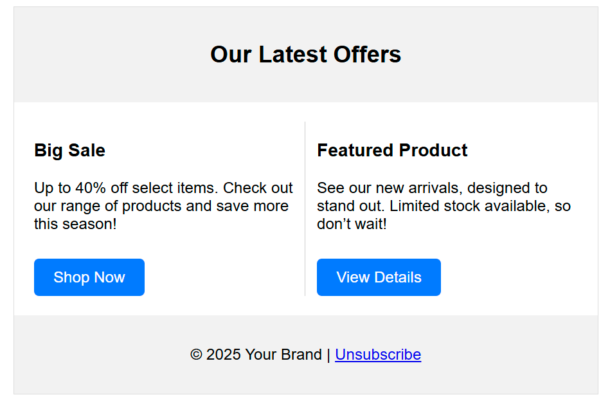
5. Use a Clear Call to Action
Tell readers exactly what you want them to do. Instead of “Learn More,” try “Download Your Free Guide” or “Shop Now”.
6. Test and Refine
Experiment with different subject lines, content arrangements, and calls to action. A/B testing tells you which approach leads to higher opens and clicks.
7. Pick the Right Campaign Type
Match your campaign style to your audience and goals:
- Newsletters: Regular updates, promotions, and valuable info
- Welcome series: Automated introductions for new subscribers
- Promotions: Special deals or discounts
- Lead nurturing: Helpful content guiding leads through the sales funnel
Essential Best Practices for Email Marketing
You’ve learned how to set goals, build a list, and craft emails. Now, let’s look at proven best practices that boost results and maintain a solid sender reputation.
- Targeted, Personalized Communication Segment your audience and cater messages to specific groups.
- Optimize Timing & Frequency Send emails when recipients are most likely to open them.
- Invest in Quality Content & Design Make your emails attractive, easy to read, and valuable.
- Leverage Automation Automated sequences for welcomes and follow-ups keep your brand top of mind.
- Use A/B Testing Often Experiment with subject lines, content, and calls to action.
- Analyze Data for Improvement Track open rates, click-through rates, and other metrics.
- Stay Legal Follow GDPR, CCPA, CAN-SPAM, and other relevant regulations.
Types of Email Campaigns
Below are some campaign styles you can use to achieve different aims:
Welcome Emails
Greet new subscribers. First impressions matter, so introduce your brand and set expectations.
Preview Example: Welcome Email
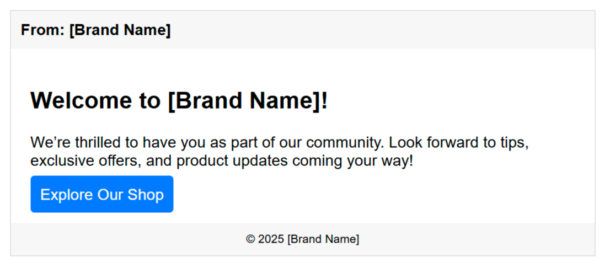
Newsletters
Stay top of mind with consistent updates, valuable content, and promotions.
Promotional Emails
Highlight special deals or newly launched products. Motivates recipients to act quickly.
Transactional Emails
Send confirmations, password resets, or shipping notifications.
Abandoned Cart Emails
Remind people of items left in their cart, encouraging them to complete a purchase.
Re-Engagement Emails
Reach out to inactive subscribers with reasons to reconnect.
Learn why your email list aren’t reading your emails.
Gauge Your Success
You’ve launched your campaigns, but how do you know they’re working? Track these metrics to make data-driven tweaks:
- Open rate: Percentage of recipients who open your email.
- Click-through rate (CTR): Percentage who click on a link in the message.
CTR = (Number of clicks ÷ Number of delivered emails) x 100 Example: - 1,000 emails delivered - 50 clicks CTR = (50 ÷ 1,000) x 100 = 5% - Conversion rate: Percentage who complete a desired action (purchase, form fill).
- Bounce rate: Percentage of undeliverable emails.
- Unsubscribe rate: Percentage who remove themselves from your list.
- Spam complaint rate: Percentage who mark your email as spam.
Studying these data points reveals what resonates with your audience and where you can improve.
Common Email Mistakes to Avoid
Even experts slip up.
Learn how to avoid these pitfalls, so you can keep your emails professional, effective, and welcomed in subscribers’ inboxes.
| Mistake | How to Avoid It |
|---|---|
| Ignoring sender reputation | Follow best practices, clean your list, and respect opt-outs. |
| Overlooking email accessibility | Add alt text, use clear formatting, ensure readable contrast. |
| Failing to segment your list | Group users by relevant attributes for more targeted emails. |
| Sending too many emails | Find a balanced frequency; watch your unsubscribe rate. |
| Not checking for errors | Proofread to avoid typos and broken links. |
| Using low-resolution images | Optimize images for different devices. |
| Clogging inboxes with attachments | Link to resources instead of large attachments. |
| Not checking your links | Ensure all links work properly. |
| Sending placeholder text | Remove filler or placeholder text before sending. |
Conclusion
Email marketing remains a powerful way to reach your audience, build relationships, and meet your business objectives. By following the steps in this guide—defining goals, building an engaged list, choosing a suitable platform, crafting strong messages, and testing your results—you can create effective email campaigns that deliver real value.
Key takeaways for beginners:
- Have a clear plan: Set goals for your emails.
- Grow a quality list: Seek engaged subscribers with explicit permission.
- Pick a suitable platform: Match your budget and feature needs.
- Develop great emails: Write concise copy, strong subject lines, and easy-to-click CTAs.
- Track performance: Study metrics like open rate and CTR, then refine your strategy.
It might feel like a lot, but a thoughtful approach to email pays dividends. Your audience is out there—ready to connect with you when you send valuable content straight to their inbox. Take that first step, and watch as meaningful customer relationships grow over time!
